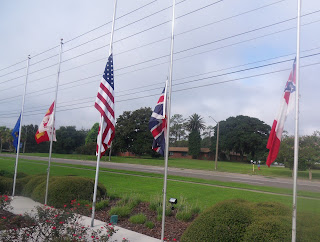by Robert A. Waters
“If the Devil owned both Hell and Florida, he would rent out Florida and live in Hell!” A United States soldier during the Second Seminole War.
In front of the county administrative complex in my hometown of Ocala, Florida, five flags have flown peacefully for years. These flags represent countries that once ruled Florida: Spain, France, Great Britain, the United States of America, and the Confederate States of America.
But a few weeks ago, in the wake of a white gunman shooting dead nine black members of a South Carolina church, the county administrator pulled the Confederate flag from the display. A day later, the county commission voted unanimously to replace the missing flag. As it was being reinstated to its rightful place in the display, the county administrator abruptly resigned.
A horde of media folks suddenly descended on our usually quiet little community. Most of these out-of-towners seemed confused and dismayed that ignorant rednecks would proudly display such a supposedly racist symbol as the Confederate flag.
What is the history of the other four flags that have flown above Marion County? Are Spain, France, England, and the United States any less culpable than the Confederate States of America?
On Spain’s first foray into the state, Pedro de Salazar enslaved hundreds of Native Americans. Then, according to Florida: Then and Now, Hernando de Soto, who arrived a few years later, in 1569, “enslaved, mutilated, and executed the natives, often without provocation.” This reign of terror continued during two centuries of Spanish rule.
In 1562, Jean Ribault and a group of French Huguenots decided to escape religious persecution in their own country and settle in the new world. They established a fort near what is now Jacksonville, where the Spaniards quickly attacked them. In an orgy of blood-letting, Spanish soldiers lined the captured French soldiers up on the beach and beheaded several hundred souls. (The area is now known as Matansas, meaning “massacre.”) This ended the short-lived French attempt to colonize Florida, but they did fly the French flag for about three years.
In 1763, Spain traded the colony of Florida to Great Britain for Havana, Cuba, which the English had previously captured.
So far, we have Spain, France, and England that have flown flags over the state. France’s sojourn in the state was brief, with few atrocities. England’s ruthless power-grabbing ways are well-documented. Without firearms, a dedicated group of patriots, and a bit of luck, Americans might be British subjects today.
In 1822, Florida became a territory of the United States. In 1835, American troops arrived to forcibly evict the Creek and Seminole Indians from their homeland. Thus began the Second Seminole War. Broken treaties, imprisonment without legal representation, forced relocation, torture, and death followed as United States troops relentlessly sought to move the Indians or wipe them out. At war’s end, only a few Seminoles remained in Florida, most seeking shelter in the nearly inaccessible Everglades.
In 1845, Florida became the 27th state to be admitted to the Union.
Florida seceded in 1861, becoming a part of the Confederate States of America. It was readmitted to the United States in 1868.
In Marion County, the five flags fly precariously, subject to the whims of political pressure. If, however, one flag is plucked from the display, maybe all the others should be taken down as well.
Except for that lone inoffensive French flag.








